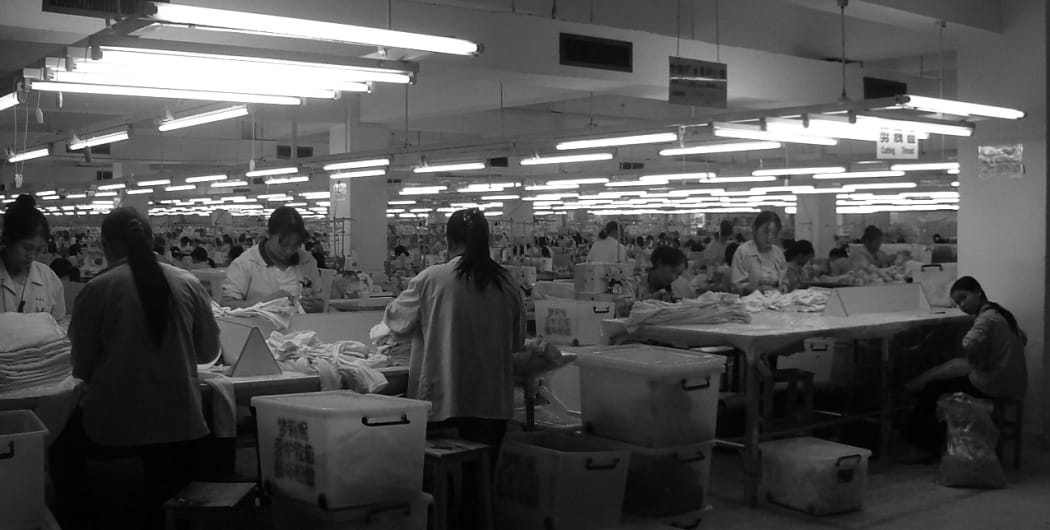The 2017 Ethical Fashion Report is out. How are your favourite Kiwi retailers doing?

A garment factory in China Photo: supplied
New Zealand companies are performing slightly better than the overall average in a report on the ethical practices of 106 clothing brands released today.
This year Tearfund has collaborated with Baptist World Aid Australia to bring New Zealand consumers the Ethical Fashion Report.
According to the report, grades given to companies - between A and F - are a measure of efforts to guard against the use of child and forced labour in its supply chain.
They are measured on “the extent to which a company has traced its suppliers and established systems throughout its supply chain that can enable it to prevent and address worker exploitation and modern slavery”.
B-minus is the median grade for Kiwi companies, while C-plus is the overall median grade.
The highest ranking New Zealand companies are Kowtow and Liminal Apparel - both receiving an A grade.
Kowtow owner Gosia Piatek describes her clothing as being “certified organic, fair trade... ethically and sustainably made from seed to garment.”
And Christchurch-based company Liminal Apparel sells bags and basics using sustainable materials manufactured by Freeset - a company that employs women trapped in Kolkata’s sex trade.
The lowest ranking New Zealand companies are those that did not respond to the survey.
Merino clothing manufacturer Icebreaker, as of publishing, did not respond to requests for comment from The Wireless.
The business, majority owned by Jeremy Moon, received a D-minus ranking due to its lack of response, though it’s website claims its practices are ethical.
Farmers, which received an F, also did not respond to either the survey, or The Wireless at the time of publishing.
Though The Warehouse Group did not participate in the survey, the company - which owns two retailers that sell clothing; The Warehouse and Torpedo 7 - did respond to questions from The Wireless.
The group has its own policy on ethical sourcing and The Warehouse’s 2017 ethical sourcing report is published online.
Through its ethical sourcing programme, established in 2004, the company says it insists on legal contracts for all workers, no child or bonded labour, fair wages and safe and ethical working conditions that meet policy standards.
The Ethical Fashion Report noted that despite its non-response, The Warehouse still scored relatively well, with a C grade. This was largely due to “their strong commitment to public transparency,” the report said.
According to Baptist World Aid Australia, non-responsive companies were given multiple opportunities to engage and could submit a written statement explaining their non-participation for inclusion in the report [The Warehouse provided a response. Icebreaker and Farmers did not.]
New Zealand company Karen Walker, and formerly New Zealand owned company Macpac both appeared among the most improved companies this year.
Macpac went from D-plus in 2016 to B-minus this year. Karen Walker went from C last year to B-plus in the 2017 report.
Other Kiwi companies given ratings were Kathmandu (B-plus), AS Colour (B), Glassons (B-minus), Ezibuy (C-plus) and Max (C).
Tearfund says a higher grade indicates the company has a labour rights management system that, if implemented well, should reduce the risk and extent of worker exploitation.
Lower graded companies are those that are not taking part in these initiatives or those choosing not to disclose if they are taking part in such initiatives
But a high grade does not mean a company has a supply chain which is free from exploitation, according to Tearfund.
“Rather it is an indicator of the efforts and the strength of a company’s systems.”
According to Baptist World Aid Australia, the Asia-Pacific region has become the “world’s garment factory” with more than 40 million workers employed in the industry.
For the majority of these workers, wages remain at levels well below what is needed to lift them and their families out of poverty.
The first fashion report was published in 2013 shortly after the Rana Plaza factory collapse in Bangladesh, which killed 1129 garment workers and injured 2515.


